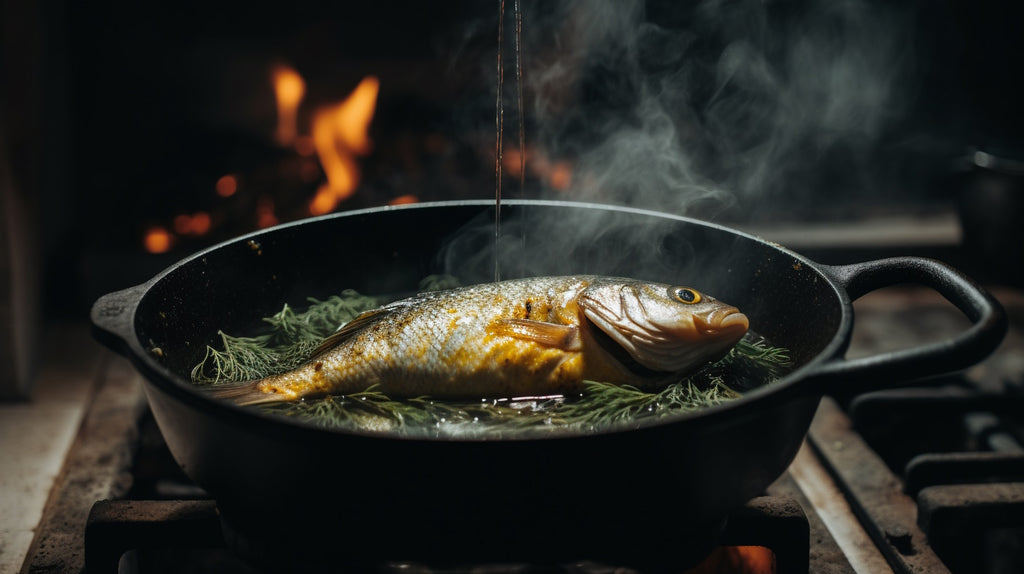Olive Oil and Fat Migration: What are the Benefits of Shallow Frying with Olive Oil?
Highlights
- The study looked at how different ways of frying fish and using different cooking oils affect the fats and oils in the fish.
- The study found that the fats and oils in the fish can move between the cooking oil and the fish itself, depending on how much of each there is.
- Extra virgin olive oil is safer than sunflower oil when it comes to making harmful compounds during frying, so it's important to choose the right cooking oil.
- The study's findings are important for people who cook and care about their health because they tell us what happens to the fats and oils in fish when we shallow-fry it.
Introduction
In the culinary world, shallow-frying is a popular cooking method known for its ability to impart delicious flavors and textures to various food items, including fish. However, the changes occurring in fish lipids and the frying oil during the frying process have been a topic of interest and concern. A recent study titled "The influence of frying technique, cooking oil, and fish species on the changes occurring in fish lipids and oil during shallow-frying, studied by 1H NMR" provides valuable insights into this area of research. The study, utilizing Proton Nuclear Magnetic Resonance spectroscopy (1H NMR), investigates the effects of frying techniques and cooking oils on the composition of fish lipids and oil.
Methodology: Unveiling the Migrations and Reactions
To investigate the changes that occur during shallow frying, the researchers studied fish fillets (farmed gilthead sea bream and European sea bass) using two commonly used cooking oils: extra virgin olive oil and sunflower oil. They used both pan-frying and microwave-frying methods. They also heated the oils alone under the same conditions. They used Proton Nuclear Magnetic Resonance spectroscopy (1H NMR) to analyze the frying oils and fish lipids, looking at the major and minor components.
Migration of Lipidic Compounds: The Exchange Between Oils and Fish
The study's findings confirmed that significant and minor lipidic compounds move between the cooking oils and fish fillets during frying. This exchange depends on the proportions of these components in the original fats. The analysis using 1H NMR provided detailed information on specific compounds present in both the oils and fish lipids, such as trans-2-alkenals, alkanals, cis,trans- and trans,trans-2,4-alkadienals, trans-9,10-epoxystearate, and 1,2-diglycerides. Importantly, no signs of primary oxidation compounds were detected, indicating that the frying process did not significantly damage the lipids through oxidation.
Thermo-Oxidation and Hydrolysis: A Tale of Frying Techniques
The study revealed an interesting discovery regarding the levels of thermo-oxidation in pan-frying and microwave-frying. Pan-frying resulted in higher levels of oil thermo-oxidation compared to microwave-frying. This difference is likely due to variations in heat transfer and exposure to air during the frying process. The study emphasized the significance of considering different frying techniques in culinary practices, as they can impact the oxidative stability of cooking oils.
Safer Oil Options: The Role of Extra Virgin Olive Oil
The study also investigated the formation of aldehydes, which are potentially harmful compounds produced when frying food. The analysis showed that extra virgin olive oil had a safer profile in terms of aldehyde formation compared to sunflower oil. This finding highlights the importance of choosing the right cooking oils for shallow-frying to reduce the formation of harmful compounds and ensure food safety.
Conclusion: Fat Migration in Frying Enhances Nutrition
Selo Croatian extra virgin olive oil holds a cherished place in Mediterranean cuisine, particularly when shallow-frying sea bass. With its exceptional quality, distinct flavor, and rich history, this exquisite olive oil enhances not only the nutritional value but also the overall taste of dishes. Its delicate and aromatic properties perfectly complement the natural flavors of fatty fish, making the culinary experience truly unforgettable. From salads to pasta sauces, Selo Croatian extra virgin olive oil continues to be a symbol of culinary excellence and cultural heritage along the Dalmatian coast, embraced by both fishermen and food enthusiasts alike.

